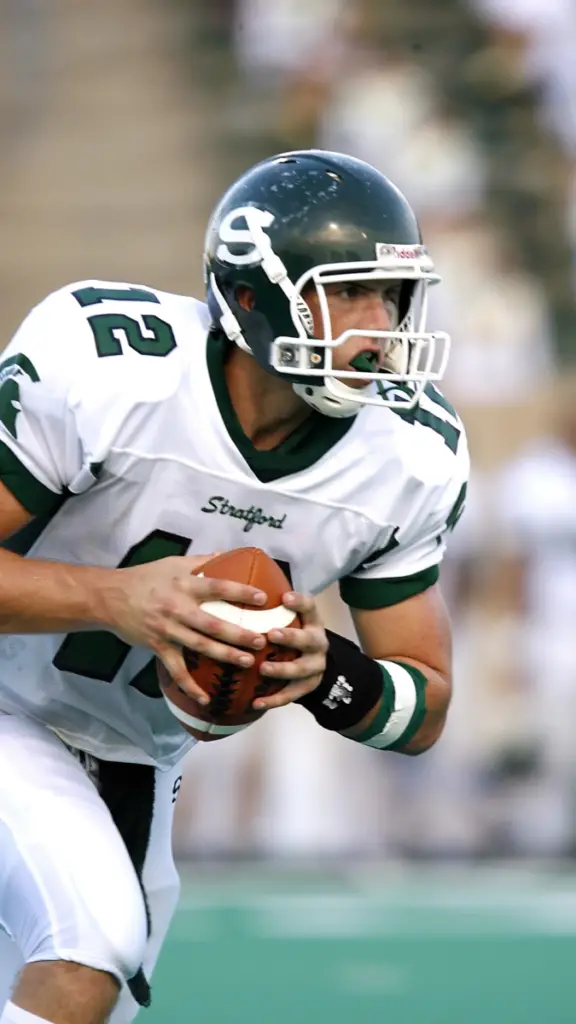Football has come a long way over the years, technology has changed, and in most cases, it has improved the overall game of football. One factor that has changed over the years is communication with coaches.
Headsets can be a definite advantage during a football game, as coaches tend to see the field really well and understand the game. After a team is lined up, coaches can make adjustments much easier if they are able to communicate with players.
Are headsets allowed in all levels of football? The answer is no, not as all levels, see below to find out what levels can use headsets.

Do Football Players Have Headsets in Their Helmets?
In the NFL, headsets are allowed, but in all other levels, headsets are banned from being used. The quarterback is allowed to have a headset and also one player on defense. Other players are not allowed to have a headset. The headset does turn off at a certain point.
Headsets are banned from all levels except for the NFL. Headsets are allowed in the NFL, but with several restrictions.
Who is Allowed to Wear a Headset on the Field?
Communication is key in football, and having the opportunity to hear from the coach from the sideline is extremely beneficial in the game of football.
On offense in the NFL, the quarterback has a headset and is allowed communication with a coach. The quarterback may hear from a coach, but there are restrictions on this.
On defense, one player on the field can communicate with a coach, usually it seems to be a linebacker in the NFL.
Who Can the Players Communicate with?
The quarterback and one defensive player can communicate with a coach on the sidelines. These players are not allowed to communicate with the coaches that are in the press box.
This rule is standard for all NFL games. If these two players could communicate with the coaches in the box, this would allow for even more of an advantage, as the view from the press box is much better than the view from the sidelines.
Can the Quarterback and Defensive Player Talk to the Coach?
The headsets that are installed in the quarterback and defensive players’ helmets are only for communication one way. The players can not talk with the coach through a microphone. It is a one-way system for communication.
This allows for a fair system and logistically much easier. Someday we may see the players with headsets being able to actually talk, but a microphone would have to be installed, which could be a bit difficult considering football is so much of a contact sport.
Does the Communication Ever Turn Off?
Yes, communication is shut off at some point before the snap. The NFL rules are that the headset is turned off with 15 seconds left on the play clock. The play clock is 40 seconds long, so the coach has 25 seconds to relay information to the quarterback or defensive player.
If the ball is snapped before the play clock runs down to 15 seconds, the communication is shut off when the ball is snapped. This rule allows for communication on each play, but if a team is hurrying to snap the ball, time is definitely limited.
What Happens if there is Technical Difficulty?
If there is technical difficulty for one team, the other team is required to turn their system off. This does make it fair for all involved.
If this does happen, teams will have a back up plan for getting plays from coaches to players. Teams will either use hand signals or run plays in with the quarterback or another player.
This forces teams to practice this scenario, especially if communication is cut off in a crucial moment of the game.
When was the Headset System Initiated?
In 1994, the headset system was allowed, and every team installed this system. The officials are able to determine who has the headset because the players that do have headsets have a green dot on the back of their helmet.
From 1994 until 2008, the only player that was allowed to have a headset in their helmet was the quarterback. In 2008, the new NFL rule was that one defensive player was allowed to have a headset as well.
How Important is the Headset in the NFL?
The headset has changed the game quite a bit. In the old days of the NFL, coaches had to get creative with how they communicated plays into the offense and defense. Coaches would use players to run plays in, and a player would come out of the game.
The problem with using runners to relay plays was that coaches had to find players that were of similar ability. This isn’t always easy to find and becomes a logistics issue at times for many teams.
The other option for coaches is to have the quarterback run over to receive the play, then relay the play to the rest of their team. The issue with this is that sometimes the play clock got low, especially if the quarterback had a long distance to get to the coach.
The other option is to signal in plays from the sideline. This is a good option, except that teams end up picking up on the signals. NFL plays can also be rather long and complicated, which makes it difficult to relay properly.
The headset system has definitely made communication easier and better for teams. Coaches in the NFL find it extremely helpful. It is one thing that coaches do not have to worry about.
Final Thoughts
The headset system is extremely helpful for coaches and players. The technology and usefulness of this system has come a long way over the years.
The NFL is the only level of play where headsets are allowed. Other levels such as youth, high school, and college are not allowed to use headsets. This causes coaches to come up with creative ways to signal in plays.
The quarterback and one defensive player use the headsets to communicate with coaches. Only the coach can speak to the player, as it is not a two-way communication system.
The headsets have proven helpful at the NFL level and may someday be used in the lower levels of football.
